Business in Practice: Report on Business Structures and Analysis
VerifiedAdded on 2022/12/26
|10
|3095
|84
Report
AI Summary
This report provides a comprehensive overview of various business types and organizational structures. It begins by classifying businesses based on size, including micro, small, medium, and large enterprises, detailing their characteristics, employee numbers, and turnover. The report then delves into different business structures such as sole trader businesses, partnerships, limited liability businesses, public limited liability businesses, and cooperatives, outlining their key features, advantages, and disadvantages. Furthermore, it explores organizational structures, specifically functional and divisional structures, and explains their implications. The report concludes with a PESTLE analysis of Lotus Cars, examining the political, economic, social, technological, legal, and environmental factors affecting the company's operations and market position. This analysis highlights the impact of external factors on the business environment and provides insights into strategic decision-making.
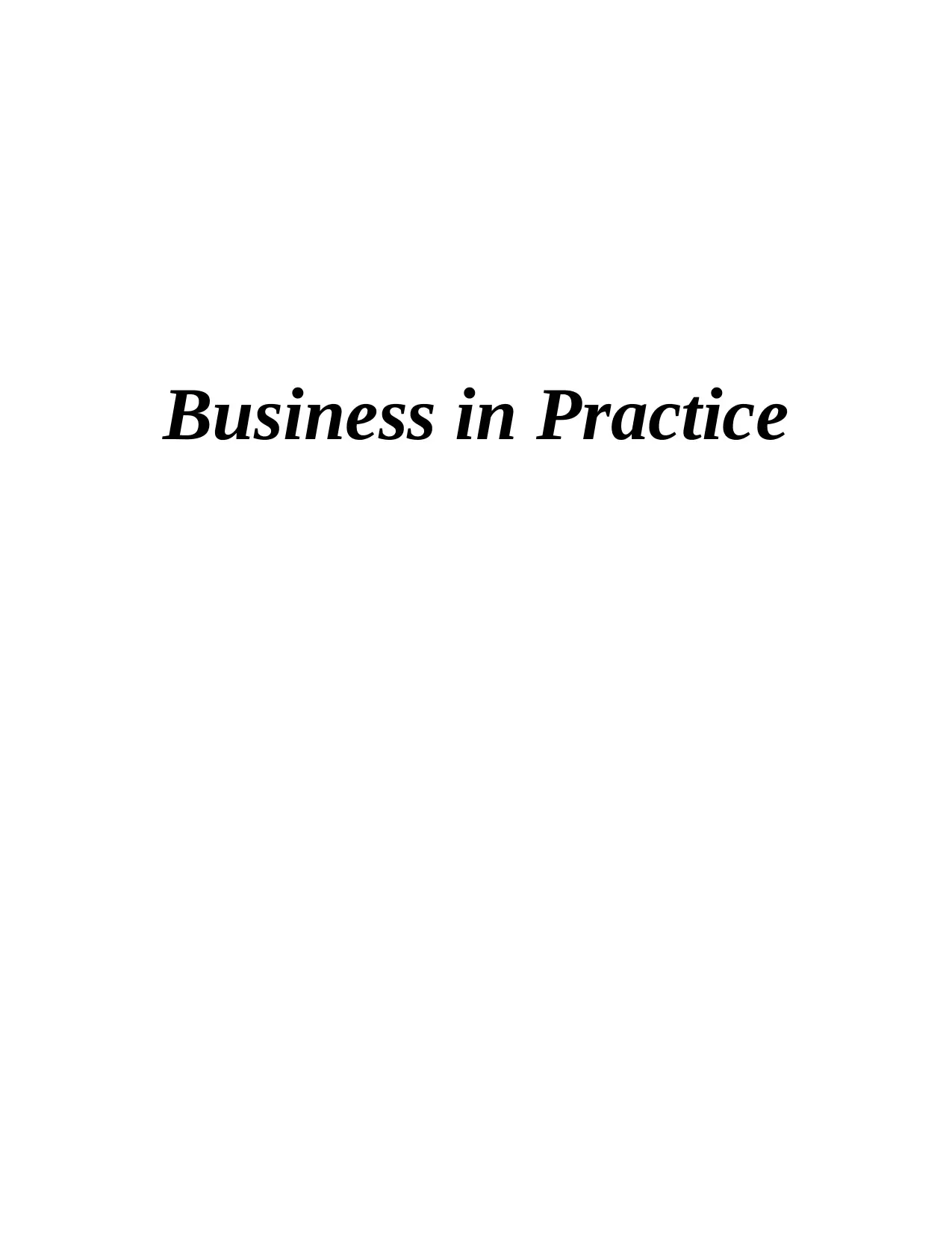
Business in Practice
Paraphrase This Document
Need a fresh take? Get an instant paraphrase of this document with our AI Paraphraser
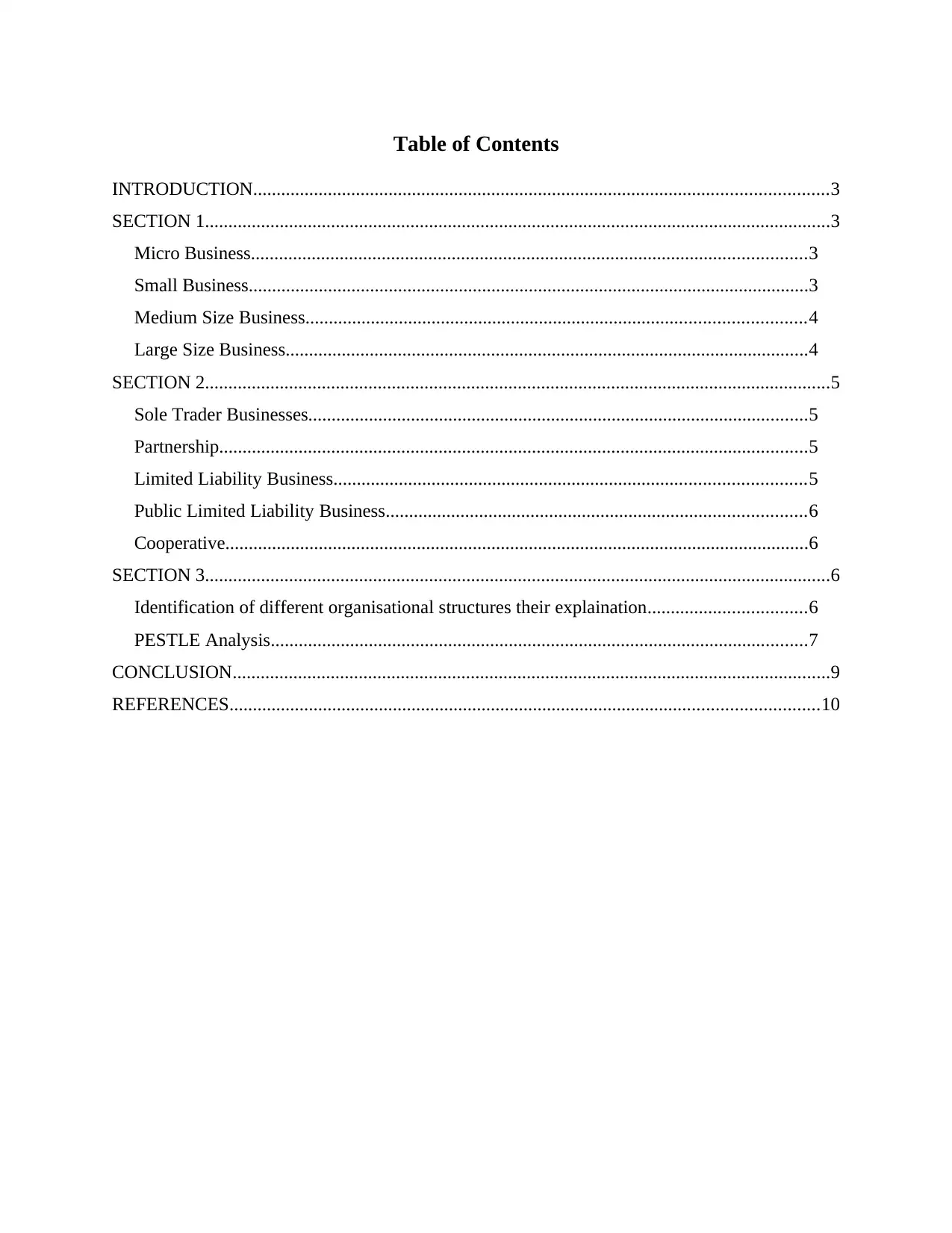
Table of Contents
INTRODUCTION...........................................................................................................................3
SECTION 1......................................................................................................................................3
Micro Business.......................................................................................................................3
Small Business........................................................................................................................3
Medium Size Business...........................................................................................................4
Large Size Business................................................................................................................4
SECTION 2......................................................................................................................................5
Sole Trader Businesses...........................................................................................................5
Partnership..............................................................................................................................5
Limited Liability Business.....................................................................................................5
Public Limited Liability Business..........................................................................................6
Cooperative.............................................................................................................................6
SECTION 3......................................................................................................................................6
Identification of different organisational structures their explaination..................................6
PESTLE Analysis...................................................................................................................7
CONCLUSION................................................................................................................................9
REFERENCES..............................................................................................................................10
INTRODUCTION...........................................................................................................................3
SECTION 1......................................................................................................................................3
Micro Business.......................................................................................................................3
Small Business........................................................................................................................3
Medium Size Business...........................................................................................................4
Large Size Business................................................................................................................4
SECTION 2......................................................................................................................................5
Sole Trader Businesses...........................................................................................................5
Partnership..............................................................................................................................5
Limited Liability Business.....................................................................................................5
Public Limited Liability Business..........................................................................................6
Cooperative.............................................................................................................................6
SECTION 3......................................................................................................................................6
Identification of different organisational structures their explaination..................................6
PESTLE Analysis...................................................................................................................7
CONCLUSION................................................................................................................................9
REFERENCES..............................................................................................................................10
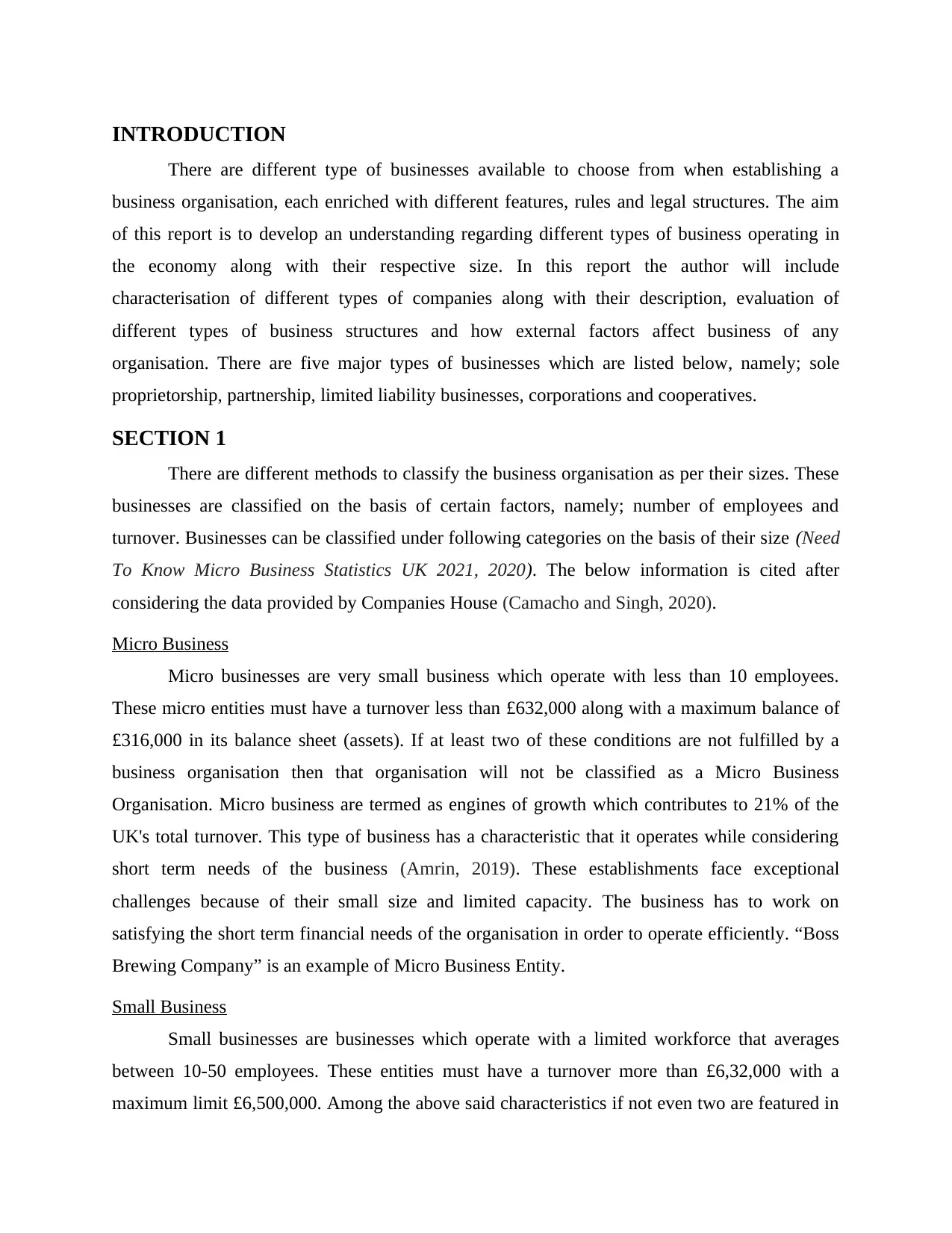
INTRODUCTION
There are different type of businesses available to choose from when establishing a
business organisation, each enriched with different features, rules and legal structures. The aim
of this report is to develop an understanding regarding different types of business operating in
the economy along with their respective size. In this report the author will include
characterisation of different types of companies along with their description, evaluation of
different types of business structures and how external factors affect business of any
organisation. There are five major types of businesses which are listed below, namely; sole
proprietorship, partnership, limited liability businesses, corporations and cooperatives.
SECTION 1
There are different methods to classify the business organisation as per their sizes. These
businesses are classified on the basis of certain factors, namely; number of employees and
turnover. Businesses can be classified under following categories on the basis of their size (Need
To Know Micro Business Statistics UK 2021, 2020). The below information is cited after
considering the data provided by Companies House (Camacho and Singh, 2020).
Micro Business
Micro businesses are very small business which operate with less than 10 employees.
These micro entities must have a turnover less than £632,000 along with a maximum balance of
£316,000 in its balance sheet (assets). If at least two of these conditions are not fulfilled by a
business organisation then that organisation will not be classified as a Micro Business
Organisation. Micro business are termed as engines of growth which contributes to 21% of the
UK's total turnover. This type of business has a characteristic that it operates while considering
short term needs of the business (Amrin, 2019). These establishments face exceptional
challenges because of their small size and limited capacity. The business has to work on
satisfying the short term financial needs of the organisation in order to operate efficiently. “Boss
Brewing Company” is an example of Micro Business Entity.
Small Business
Small businesses are businesses which operate with a limited workforce that averages
between 10-50 employees. These entities must have a turnover more than £6,32,000 with a
maximum limit £6,500,000. Among the above said characteristics if not even two are featured in
There are different type of businesses available to choose from when establishing a
business organisation, each enriched with different features, rules and legal structures. The aim
of this report is to develop an understanding regarding different types of business operating in
the economy along with their respective size. In this report the author will include
characterisation of different types of companies along with their description, evaluation of
different types of business structures and how external factors affect business of any
organisation. There are five major types of businesses which are listed below, namely; sole
proprietorship, partnership, limited liability businesses, corporations and cooperatives.
SECTION 1
There are different methods to classify the business organisation as per their sizes. These
businesses are classified on the basis of certain factors, namely; number of employees and
turnover. Businesses can be classified under following categories on the basis of their size (Need
To Know Micro Business Statistics UK 2021, 2020). The below information is cited after
considering the data provided by Companies House (Camacho and Singh, 2020).
Micro Business
Micro businesses are very small business which operate with less than 10 employees.
These micro entities must have a turnover less than £632,000 along with a maximum balance of
£316,000 in its balance sheet (assets). If at least two of these conditions are not fulfilled by a
business organisation then that organisation will not be classified as a Micro Business
Organisation. Micro business are termed as engines of growth which contributes to 21% of the
UK's total turnover. This type of business has a characteristic that it operates while considering
short term needs of the business (Amrin, 2019). These establishments face exceptional
challenges because of their small size and limited capacity. The business has to work on
satisfying the short term financial needs of the organisation in order to operate efficiently. “Boss
Brewing Company” is an example of Micro Business Entity.
Small Business
Small businesses are businesses which operate with a limited workforce that averages
between 10-50 employees. These entities must have a turnover more than £6,32,000 with a
maximum limit £6,500,000. Among the above said characteristics if not even two are featured in
⊘ This is a preview!⊘
Do you want full access?
Subscribe today to unlock all pages.

Trusted by 1+ million students worldwide
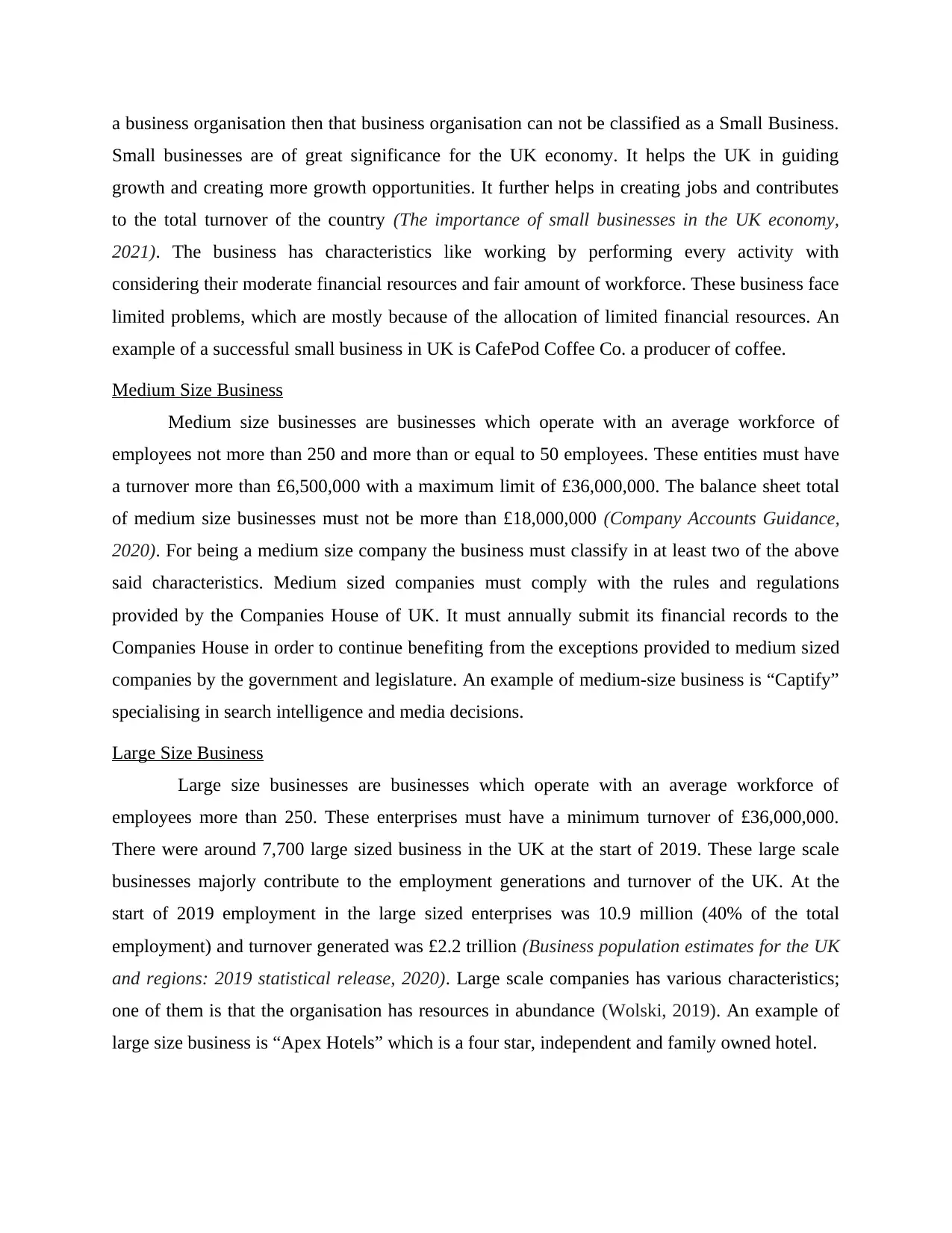
a business organisation then that business organisation can not be classified as a Small Business.
Small businesses are of great significance for the UK economy. It helps the UK in guiding
growth and creating more growth opportunities. It further helps in creating jobs and contributes
to the total turnover of the country (The importance of small businesses in the UK economy,
2021). The business has characteristics like working by performing every activity with
considering their moderate financial resources and fair amount of workforce. These business face
limited problems, which are mostly because of the allocation of limited financial resources. An
example of a successful small business in UK is CafePod Coffee Co. a producer of coffee.
Medium Size Business
Medium size businesses are businesses which operate with an average workforce of
employees not more than 250 and more than or equal to 50 employees. These entities must have
a turnover more than £6,500,000 with a maximum limit of £36,000,000. The balance sheet total
of medium size businesses must not be more than £18,000,000 (Company Accounts Guidance,
2020). For being a medium size company the business must classify in at least two of the above
said characteristics. Medium sized companies must comply with the rules and regulations
provided by the Companies House of UK. It must annually submit its financial records to the
Companies House in order to continue benefiting from the exceptions provided to medium sized
companies by the government and legislature. An example of medium-size business is “Captify”
specialising in search intelligence and media decisions.
Large Size Business
Large size businesses are businesses which operate with an average workforce of
employees more than 250. These enterprises must have a minimum turnover of £36,000,000.
There were around 7,700 large sized business in the UK at the start of 2019. These large scale
businesses majorly contribute to the employment generations and turnover of the UK. At the
start of 2019 employment in the large sized enterprises was 10.9 million (40% of the total
employment) and turnover generated was £2.2 trillion (Business population estimates for the UK
and regions: 2019 statistical release, 2020). Large scale companies has various characteristics;
one of them is that the organisation has resources in abundance (Wolski, 2019). An example of
large size business is “Apex Hotels” which is a four star, independent and family owned hotel.
Small businesses are of great significance for the UK economy. It helps the UK in guiding
growth and creating more growth opportunities. It further helps in creating jobs and contributes
to the total turnover of the country (The importance of small businesses in the UK economy,
2021). The business has characteristics like working by performing every activity with
considering their moderate financial resources and fair amount of workforce. These business face
limited problems, which are mostly because of the allocation of limited financial resources. An
example of a successful small business in UK is CafePod Coffee Co. a producer of coffee.
Medium Size Business
Medium size businesses are businesses which operate with an average workforce of
employees not more than 250 and more than or equal to 50 employees. These entities must have
a turnover more than £6,500,000 with a maximum limit of £36,000,000. The balance sheet total
of medium size businesses must not be more than £18,000,000 (Company Accounts Guidance,
2020). For being a medium size company the business must classify in at least two of the above
said characteristics. Medium sized companies must comply with the rules and regulations
provided by the Companies House of UK. It must annually submit its financial records to the
Companies House in order to continue benefiting from the exceptions provided to medium sized
companies by the government and legislature. An example of medium-size business is “Captify”
specialising in search intelligence and media decisions.
Large Size Business
Large size businesses are businesses which operate with an average workforce of
employees more than 250. These enterprises must have a minimum turnover of £36,000,000.
There were around 7,700 large sized business in the UK at the start of 2019. These large scale
businesses majorly contribute to the employment generations and turnover of the UK. At the
start of 2019 employment in the large sized enterprises was 10.9 million (40% of the total
employment) and turnover generated was £2.2 trillion (Business population estimates for the UK
and regions: 2019 statistical release, 2020). Large scale companies has various characteristics;
one of them is that the organisation has resources in abundance (Wolski, 2019). An example of
large size business is “Apex Hotels” which is a four star, independent and family owned hotel.
Paraphrase This Document
Need a fresh take? Get an instant paraphrase of this document with our AI Paraphraser
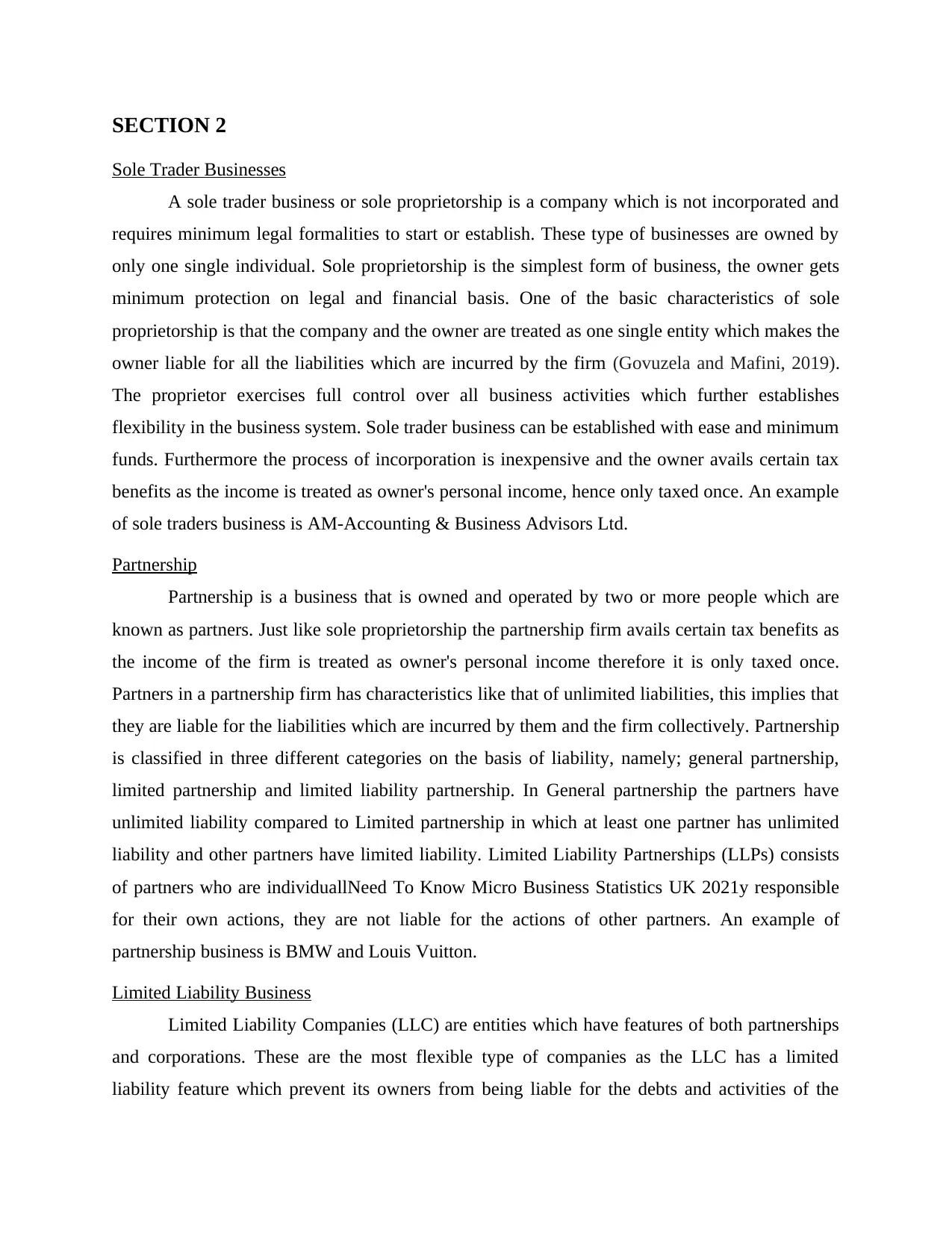
SECTION 2
Sole Trader Businesses
A sole trader business or sole proprietorship is a company which is not incorporated and
requires minimum legal formalities to start or establish. These type of businesses are owned by
only one single individual. Sole proprietorship is the simplest form of business, the owner gets
minimum protection on legal and financial basis. One of the basic characteristics of sole
proprietorship is that the company and the owner are treated as one single entity which makes the
owner liable for all the liabilities which are incurred by the firm (Govuzela and Mafini, 2019).
The proprietor exercises full control over all business activities which further establishes
flexibility in the business system. Sole trader business can be established with ease and minimum
funds. Furthermore the process of incorporation is inexpensive and the owner avails certain tax
benefits as the income is treated as owner's personal income, hence only taxed once. An example
of sole traders business is AM-Accounting & Business Advisors Ltd.
Partnership
Partnership is a business that is owned and operated by two or more people which are
known as partners. Just like sole proprietorship the partnership firm avails certain tax benefits as
the income of the firm is treated as owner's personal income therefore it is only taxed once.
Partners in a partnership firm has characteristics like that of unlimited liabilities, this implies that
they are liable for the liabilities which are incurred by them and the firm collectively. Partnership
is classified in three different categories on the basis of liability, namely; general partnership,
limited partnership and limited liability partnership. In General partnership the partners have
unlimited liability compared to Limited partnership in which at least one partner has unlimited
liability and other partners have limited liability. Limited Liability Partnerships (LLPs) consists
of partners who are individuallNeed To Know Micro Business Statistics UK 2021y responsible
for their own actions, they are not liable for the actions of other partners. An example of
partnership business is BMW and Louis Vuitton.
Limited Liability Business
Limited Liability Companies (LLC) are entities which have features of both partnerships
and corporations. These are the most flexible type of companies as the LLC has a limited
liability feature which prevent its owners from being liable for the debts and activities of the
Sole Trader Businesses
A sole trader business or sole proprietorship is a company which is not incorporated and
requires minimum legal formalities to start or establish. These type of businesses are owned by
only one single individual. Sole proprietorship is the simplest form of business, the owner gets
minimum protection on legal and financial basis. One of the basic characteristics of sole
proprietorship is that the company and the owner are treated as one single entity which makes the
owner liable for all the liabilities which are incurred by the firm (Govuzela and Mafini, 2019).
The proprietor exercises full control over all business activities which further establishes
flexibility in the business system. Sole trader business can be established with ease and minimum
funds. Furthermore the process of incorporation is inexpensive and the owner avails certain tax
benefits as the income is treated as owner's personal income, hence only taxed once. An example
of sole traders business is AM-Accounting & Business Advisors Ltd.
Partnership
Partnership is a business that is owned and operated by two or more people which are
known as partners. Just like sole proprietorship the partnership firm avails certain tax benefits as
the income of the firm is treated as owner's personal income therefore it is only taxed once.
Partners in a partnership firm has characteristics like that of unlimited liabilities, this implies that
they are liable for the liabilities which are incurred by them and the firm collectively. Partnership
is classified in three different categories on the basis of liability, namely; general partnership,
limited partnership and limited liability partnership. In General partnership the partners have
unlimited liability compared to Limited partnership in which at least one partner has unlimited
liability and other partners have limited liability. Limited Liability Partnerships (LLPs) consists
of partners who are individuallNeed To Know Micro Business Statistics UK 2021y responsible
for their own actions, they are not liable for the actions of other partners. An example of
partnership business is BMW and Louis Vuitton.
Limited Liability Business
Limited Liability Companies (LLC) are entities which have features of both partnerships
and corporations. These are the most flexible type of companies as the LLC has a limited
liability feature which prevent its owners from being liable for the debts and activities of the
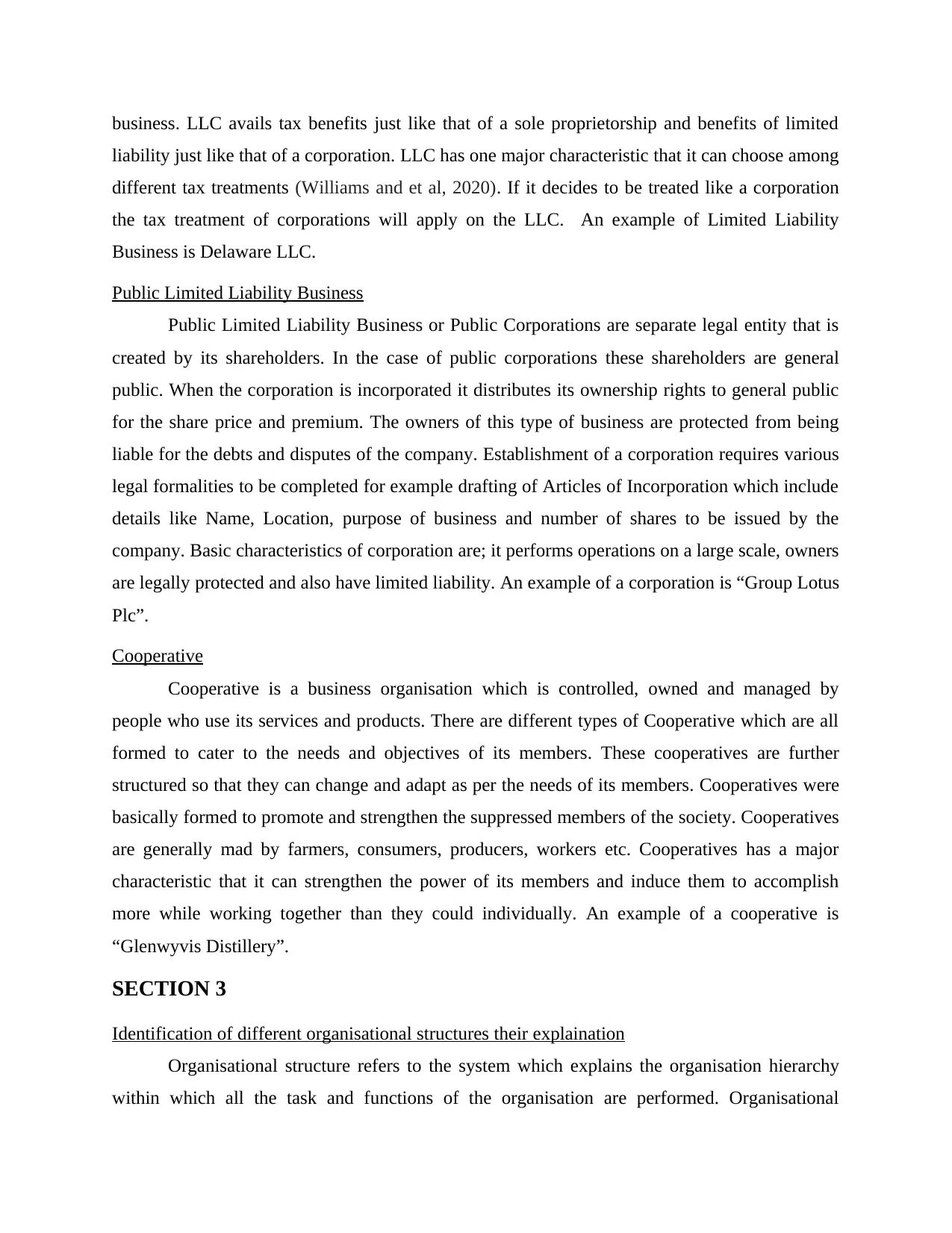
business. LLC avails tax benefits just like that of a sole proprietorship and benefits of limited
liability just like that of a corporation. LLC has one major characteristic that it can choose among
different tax treatments (Williams and et al, 2020). If it decides to be treated like a corporation
the tax treatment of corporations will apply on the LLC. An example of Limited Liability
Business is Delaware LLC.
Public Limited Liability Business
Public Limited Liability Business or Public Corporations are separate legal entity that is
created by its shareholders. In the case of public corporations these shareholders are general
public. When the corporation is incorporated it distributes its ownership rights to general public
for the share price and premium. The owners of this type of business are protected from being
liable for the debts and disputes of the company. Establishment of a corporation requires various
legal formalities to be completed for example drafting of Articles of Incorporation which include
details like Name, Location, purpose of business and number of shares to be issued by the
company. Basic characteristics of corporation are; it performs operations on a large scale, owners
are legally protected and also have limited liability. An example of a corporation is “Group Lotus
Plc”.
Cooperative
Cooperative is a business organisation which is controlled, owned and managed by
people who use its services and products. There are different types of Cooperative which are all
formed to cater to the needs and objectives of its members. These cooperatives are further
structured so that they can change and adapt as per the needs of its members. Cooperatives were
basically formed to promote and strengthen the suppressed members of the society. Cooperatives
are generally mad by farmers, consumers, producers, workers etc. Cooperatives has a major
characteristic that it can strengthen the power of its members and induce them to accomplish
more while working together than they could individually. An example of a cooperative is
“Glenwyvis Distillery”.
SECTION 3
Identification of different organisational structures their explaination
Organisational structure refers to the system which explains the organisation hierarchy
within which all the task and functions of the organisation are performed. Organisational
liability just like that of a corporation. LLC has one major characteristic that it can choose among
different tax treatments (Williams and et al, 2020). If it decides to be treated like a corporation
the tax treatment of corporations will apply on the LLC. An example of Limited Liability
Business is Delaware LLC.
Public Limited Liability Business
Public Limited Liability Business or Public Corporations are separate legal entity that is
created by its shareholders. In the case of public corporations these shareholders are general
public. When the corporation is incorporated it distributes its ownership rights to general public
for the share price and premium. The owners of this type of business are protected from being
liable for the debts and disputes of the company. Establishment of a corporation requires various
legal formalities to be completed for example drafting of Articles of Incorporation which include
details like Name, Location, purpose of business and number of shares to be issued by the
company. Basic characteristics of corporation are; it performs operations on a large scale, owners
are legally protected and also have limited liability. An example of a corporation is “Group Lotus
Plc”.
Cooperative
Cooperative is a business organisation which is controlled, owned and managed by
people who use its services and products. There are different types of Cooperative which are all
formed to cater to the needs and objectives of its members. These cooperatives are further
structured so that they can change and adapt as per the needs of its members. Cooperatives were
basically formed to promote and strengthen the suppressed members of the society. Cooperatives
are generally mad by farmers, consumers, producers, workers etc. Cooperatives has a major
characteristic that it can strengthen the power of its members and induce them to accomplish
more while working together than they could individually. An example of a cooperative is
“Glenwyvis Distillery”.
SECTION 3
Identification of different organisational structures their explaination
Organisational structure refers to the system which explains the organisation hierarchy
within which all the task and functions of the organisation are performed. Organisational
⊘ This is a preview!⊘
Do you want full access?
Subscribe today to unlock all pages.

Trusted by 1+ million students worldwide
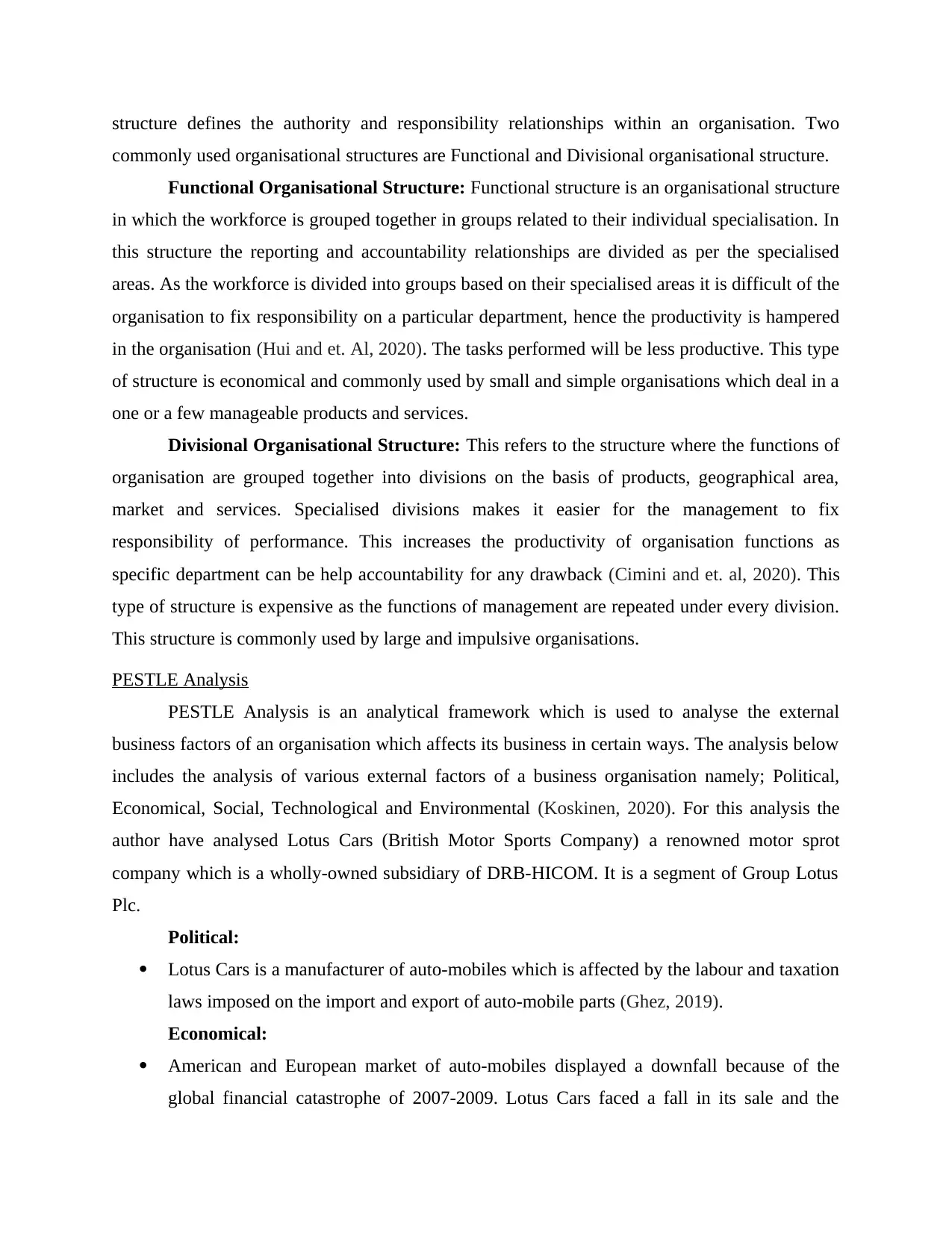
structure defines the authority and responsibility relationships within an organisation. Two
commonly used organisational structures are Functional and Divisional organisational structure.
Functional Organisational Structure: Functional structure is an organisational structure
in which the workforce is grouped together in groups related to their individual specialisation. In
this structure the reporting and accountability relationships are divided as per the specialised
areas. As the workforce is divided into groups based on their specialised areas it is difficult of the
organisation to fix responsibility on a particular department, hence the productivity is hampered
in the organisation (Hui and et. Al, 2020). The tasks performed will be less productive. This type
of structure is economical and commonly used by small and simple organisations which deal in a
one or a few manageable products and services.
Divisional Organisational Structure: This refers to the structure where the functions of
organisation are grouped together into divisions on the basis of products, geographical area,
market and services. Specialised divisions makes it easier for the management to fix
responsibility of performance. This increases the productivity of organisation functions as
specific department can be help accountability for any drawback (Cimini and et. al, 2020). This
type of structure is expensive as the functions of management are repeated under every division.
This structure is commonly used by large and impulsive organisations.
PESTLE Analysis
PESTLE Analysis is an analytical framework which is used to analyse the external
business factors of an organisation which affects its business in certain ways. The analysis below
includes the analysis of various external factors of a business organisation namely; Political,
Economical, Social, Technological and Environmental (Koskinen, 2020). For this analysis the
author have analysed Lotus Cars (British Motor Sports Company) a renowned motor sprot
company which is a wholly-owned subsidiary of DRB-HICOM. It is a segment of Group Lotus
Plc.
Political:
Lotus Cars is a manufacturer of auto-mobiles which is affected by the labour and taxation
laws imposed on the import and export of auto-mobile parts (Ghez, 2019).
Economical:
American and European market of auto-mobiles displayed a downfall because of the
global financial catastrophe of 2007-2009. Lotus Cars faced a fall in its sale and the
commonly used organisational structures are Functional and Divisional organisational structure.
Functional Organisational Structure: Functional structure is an organisational structure
in which the workforce is grouped together in groups related to their individual specialisation. In
this structure the reporting and accountability relationships are divided as per the specialised
areas. As the workforce is divided into groups based on their specialised areas it is difficult of the
organisation to fix responsibility on a particular department, hence the productivity is hampered
in the organisation (Hui and et. Al, 2020). The tasks performed will be less productive. This type
of structure is economical and commonly used by small and simple organisations which deal in a
one or a few manageable products and services.
Divisional Organisational Structure: This refers to the structure where the functions of
organisation are grouped together into divisions on the basis of products, geographical area,
market and services. Specialised divisions makes it easier for the management to fix
responsibility of performance. This increases the productivity of organisation functions as
specific department can be help accountability for any drawback (Cimini and et. al, 2020). This
type of structure is expensive as the functions of management are repeated under every division.
This structure is commonly used by large and impulsive organisations.
PESTLE Analysis
PESTLE Analysis is an analytical framework which is used to analyse the external
business factors of an organisation which affects its business in certain ways. The analysis below
includes the analysis of various external factors of a business organisation namely; Political,
Economical, Social, Technological and Environmental (Koskinen, 2020). For this analysis the
author have analysed Lotus Cars (British Motor Sports Company) a renowned motor sprot
company which is a wholly-owned subsidiary of DRB-HICOM. It is a segment of Group Lotus
Plc.
Political:
Lotus Cars is a manufacturer of auto-mobiles which is affected by the labour and taxation
laws imposed on the import and export of auto-mobile parts (Ghez, 2019).
Economical:
American and European market of auto-mobiles displayed a downfall because of the
global financial catastrophe of 2007-2009. Lotus Cars faced a fall in its sale and the
Paraphrase This Document
Need a fresh take? Get an instant paraphrase of this document with our AI Paraphraser
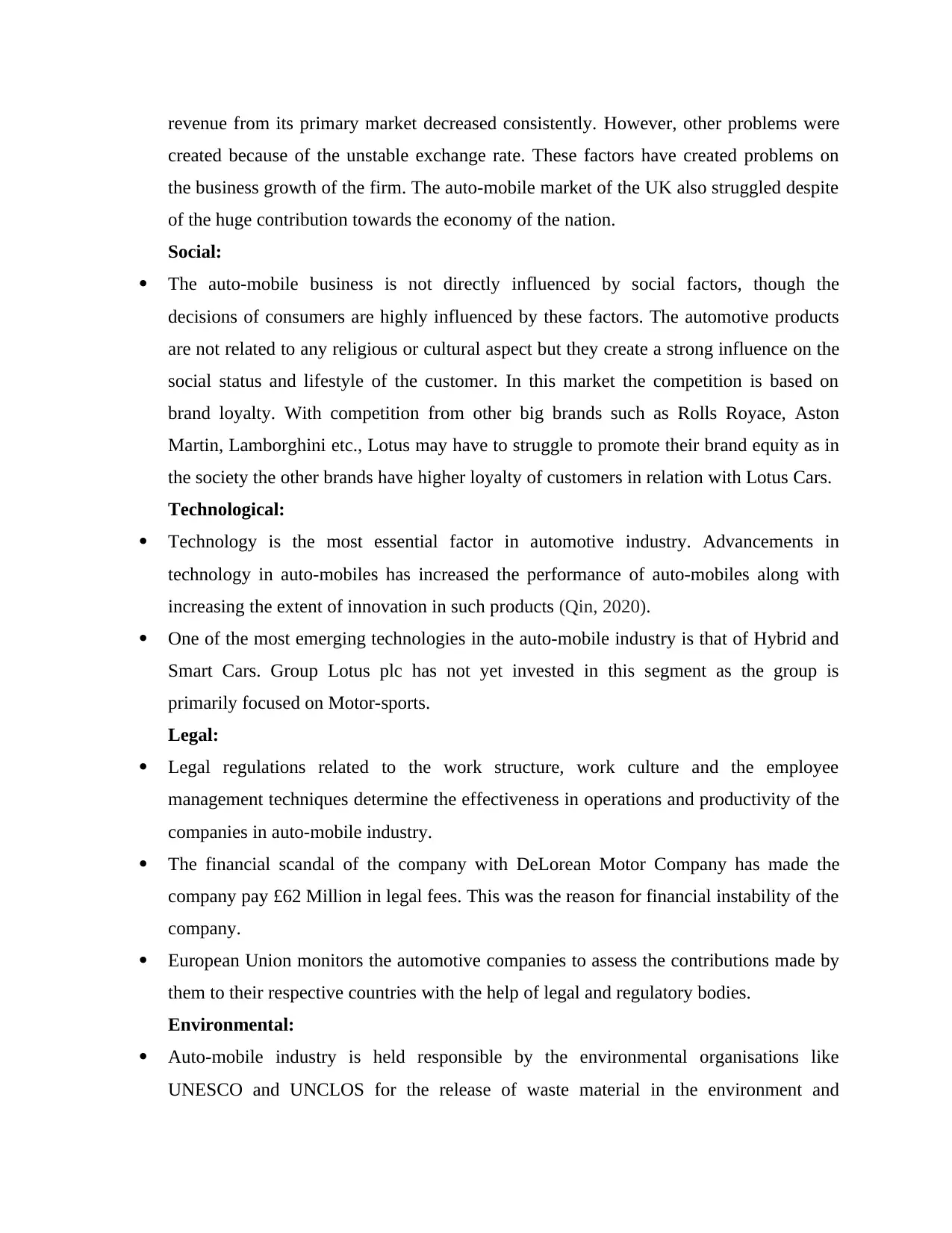
revenue from its primary market decreased consistently. However, other problems were
created because of the unstable exchange rate. These factors have created problems on
the business growth of the firm. The auto-mobile market of the UK also struggled despite
of the huge contribution towards the economy of the nation.
Social:
The auto-mobile business is not directly influenced by social factors, though the
decisions of consumers are highly influenced by these factors. The automotive products
are not related to any religious or cultural aspect but they create a strong influence on the
social status and lifestyle of the customer. In this market the competition is based on
brand loyalty. With competition from other big brands such as Rolls Royace, Aston
Martin, Lamborghini etc., Lotus may have to struggle to promote their brand equity as in
the society the other brands have higher loyalty of customers in relation with Lotus Cars.
Technological:
Technology is the most essential factor in automotive industry. Advancements in
technology in auto-mobiles has increased the performance of auto-mobiles along with
increasing the extent of innovation in such products (Qin, 2020).
One of the most emerging technologies in the auto-mobile industry is that of Hybrid and
Smart Cars. Group Lotus plc has not yet invested in this segment as the group is
primarily focused on Motor-sports.
Legal:
Legal regulations related to the work structure, work culture and the employee
management techniques determine the effectiveness in operations and productivity of the
companies in auto-mobile industry.
The financial scandal of the company with DeLorean Motor Company has made the
company pay £62 Million in legal fees. This was the reason for financial instability of the
company.
European Union monitors the automotive companies to assess the contributions made by
them to their respective countries with the help of legal and regulatory bodies.
Environmental:
Auto-mobile industry is held responsible by the environmental organisations like
UNESCO and UNCLOS for the release of waste material in the environment and
created because of the unstable exchange rate. These factors have created problems on
the business growth of the firm. The auto-mobile market of the UK also struggled despite
of the huge contribution towards the economy of the nation.
Social:
The auto-mobile business is not directly influenced by social factors, though the
decisions of consumers are highly influenced by these factors. The automotive products
are not related to any religious or cultural aspect but they create a strong influence on the
social status and lifestyle of the customer. In this market the competition is based on
brand loyalty. With competition from other big brands such as Rolls Royace, Aston
Martin, Lamborghini etc., Lotus may have to struggle to promote their brand equity as in
the society the other brands have higher loyalty of customers in relation with Lotus Cars.
Technological:
Technology is the most essential factor in automotive industry. Advancements in
technology in auto-mobiles has increased the performance of auto-mobiles along with
increasing the extent of innovation in such products (Qin, 2020).
One of the most emerging technologies in the auto-mobile industry is that of Hybrid and
Smart Cars. Group Lotus plc has not yet invested in this segment as the group is
primarily focused on Motor-sports.
Legal:
Legal regulations related to the work structure, work culture and the employee
management techniques determine the effectiveness in operations and productivity of the
companies in auto-mobile industry.
The financial scandal of the company with DeLorean Motor Company has made the
company pay £62 Million in legal fees. This was the reason for financial instability of the
company.
European Union monitors the automotive companies to assess the contributions made by
them to their respective countries with the help of legal and regulatory bodies.
Environmental:
Auto-mobile industry is held responsible by the environmental organisations like
UNESCO and UNCLOS for the release of waste material in the environment and
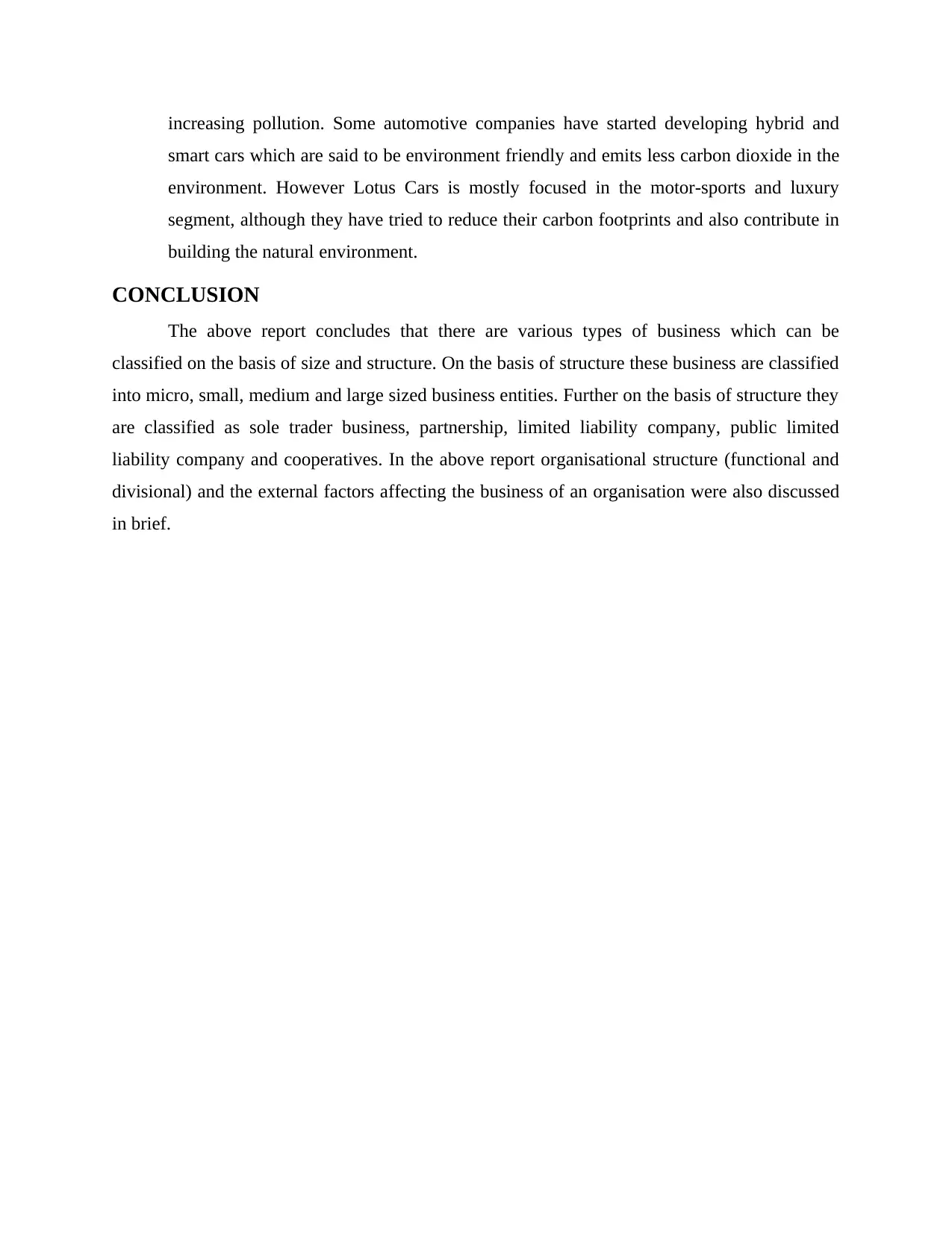
increasing pollution. Some automotive companies have started developing hybrid and
smart cars which are said to be environment friendly and emits less carbon dioxide in the
environment. However Lotus Cars is mostly focused in the motor-sports and luxury
segment, although they have tried to reduce their carbon footprints and also contribute in
building the natural environment.
CONCLUSION
The above report concludes that there are various types of business which can be
classified on the basis of size and structure. On the basis of structure these business are classified
into micro, small, medium and large sized business entities. Further on the basis of structure they
are classified as sole trader business, partnership, limited liability company, public limited
liability company and cooperatives. In the above report organisational structure (functional and
divisional) and the external factors affecting the business of an organisation were also discussed
in brief.
smart cars which are said to be environment friendly and emits less carbon dioxide in the
environment. However Lotus Cars is mostly focused in the motor-sports and luxury
segment, although they have tried to reduce their carbon footprints and also contribute in
building the natural environment.
CONCLUSION
The above report concludes that there are various types of business which can be
classified on the basis of size and structure. On the basis of structure these business are classified
into micro, small, medium and large sized business entities. Further on the basis of structure they
are classified as sole trader business, partnership, limited liability company, public limited
liability company and cooperatives. In the above report organisational structure (functional and
divisional) and the external factors affecting the business of an organisation were also discussed
in brief.
⊘ This is a preview!⊘
Do you want full access?
Subscribe today to unlock all pages.

Trusted by 1+ million students worldwide
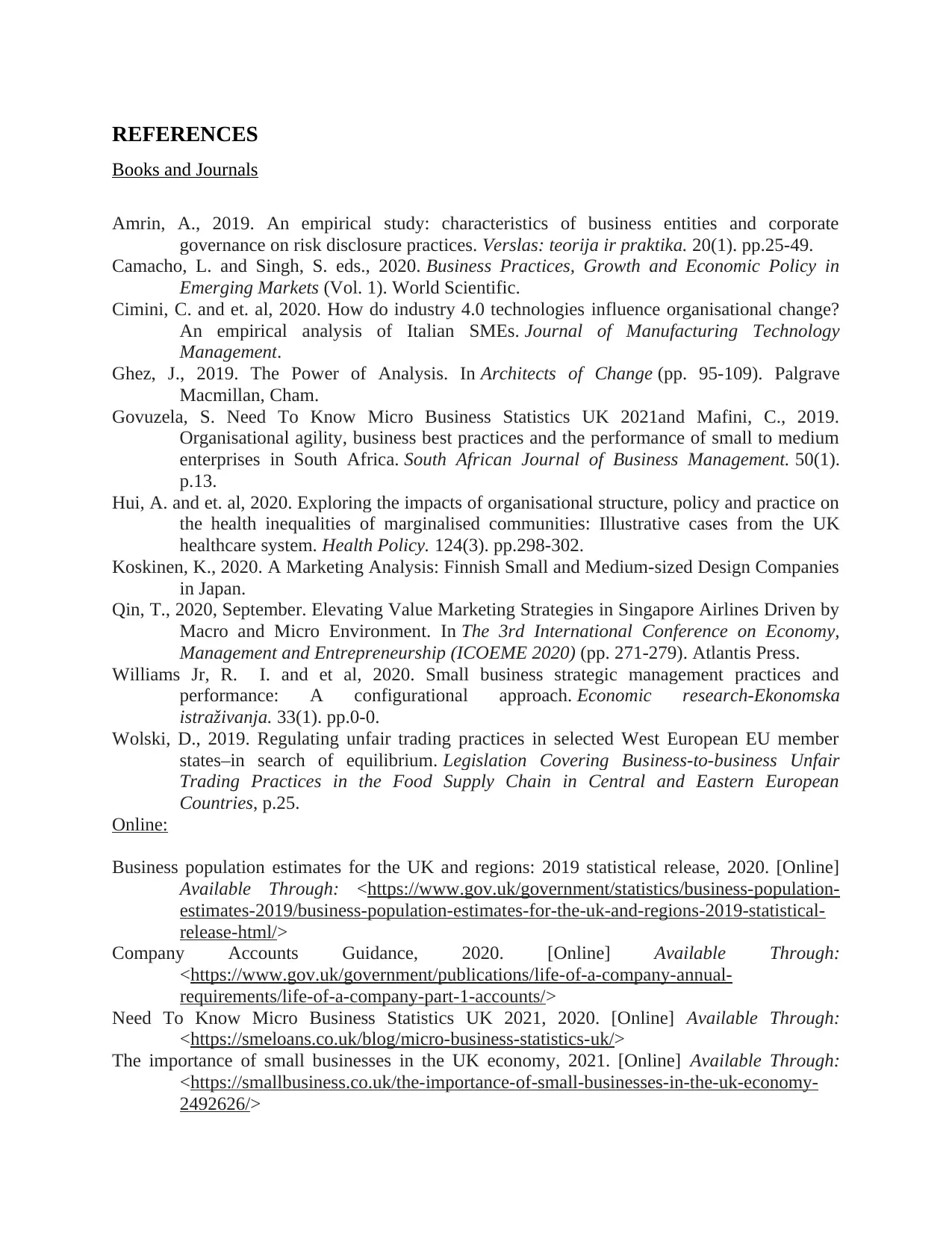
REFERENCES
Books and Journals
Amrin, A., 2019. An empirical study: characteristics of business entities and corporate
governance on risk disclosure practices. Verslas: teorija ir praktika. 20(1). pp.25-49.
Camacho, L. and Singh, S. eds., 2020. Business Practices, Growth and Economic Policy in
Emerging Markets (Vol. 1). World Scientific.
Cimini, C. and et. al, 2020. How do industry 4.0 technologies influence organisational change?
An empirical analysis of Italian SMEs. Journal of Manufacturing Technology
Management.
Ghez, J., 2019. The Power of Analysis. In Architects of Change (pp. 95-109). Palgrave
Macmillan, Cham.
Govuzela, S. Need To Know Micro Business Statistics UK 2021and Mafini, C., 2019.
Organisational agility, business best practices and the performance of small to medium
enterprises in South Africa. South African Journal of Business Management. 50(1).
p.13.
Hui, A. and et. al, 2020. Exploring the impacts of organisational structure, policy and practice on
the health inequalities of marginalised communities: Illustrative cases from the UK
healthcare system. Health Policy. 124(3). pp.298-302.
Koskinen, K., 2020. A Marketing Analysis: Finnish Small and Medium-sized Design Companies
in Japan.
Qin, T., 2020, September. Elevating Value Marketing Strategies in Singapore Airlines Driven by
Macro and Micro Environment. In The 3rd International Conference on Economy,
Management and Entrepreneurship (ICOEME 2020) (pp. 271-279). Atlantis Press.
Williams Jr, R. I. and et al, 2020. Small business strategic management practices and
performance: A configurational approach. Economic research-Ekonomska
istraživanja. 33(1). pp.0-0.
Wolski, D., 2019. Regulating unfair trading practices in selected West European EU member
states–in search of equilibrium. Legislation Covering Business-to-business Unfair
Trading Practices in the Food Supply Chain in Central and Eastern European
Countries, p.25.
Online:
Business population estimates for the UK and regions: 2019 statistical release, 2020. [Online]
Available Through: <https://www.gov.uk/government/statistics/business-population-
estimates-2019/business-population-estimates-for-the-uk-and-regions-2019-statistical-
release-html/>
Company Accounts Guidance, 2020. [Online] Available Through:
<https://www.gov.uk/government/publications/life-of-a-company-annual-
requirements/life-of-a-company-part-1-accounts/>
Need To Know Micro Business Statistics UK 2021, 2020. [Online] Available Through:
<https://smeloans.co.uk/blog/micro-business-statistics-uk/>
The importance of small businesses in the UK economy, 2021. [Online] Available Through:
<https://smallbusiness.co.uk/the-importance-of-small-businesses-in-the-uk-economy-
2492626/>
Books and Journals
Amrin, A., 2019. An empirical study: characteristics of business entities and corporate
governance on risk disclosure practices. Verslas: teorija ir praktika. 20(1). pp.25-49.
Camacho, L. and Singh, S. eds., 2020. Business Practices, Growth and Economic Policy in
Emerging Markets (Vol. 1). World Scientific.
Cimini, C. and et. al, 2020. How do industry 4.0 technologies influence organisational change?
An empirical analysis of Italian SMEs. Journal of Manufacturing Technology
Management.
Ghez, J., 2019. The Power of Analysis. In Architects of Change (pp. 95-109). Palgrave
Macmillan, Cham.
Govuzela, S. Need To Know Micro Business Statistics UK 2021and Mafini, C., 2019.
Organisational agility, business best practices and the performance of small to medium
enterprises in South Africa. South African Journal of Business Management. 50(1).
p.13.
Hui, A. and et. al, 2020. Exploring the impacts of organisational structure, policy and practice on
the health inequalities of marginalised communities: Illustrative cases from the UK
healthcare system. Health Policy. 124(3). pp.298-302.
Koskinen, K., 2020. A Marketing Analysis: Finnish Small and Medium-sized Design Companies
in Japan.
Qin, T., 2020, September. Elevating Value Marketing Strategies in Singapore Airlines Driven by
Macro and Micro Environment. In The 3rd International Conference on Economy,
Management and Entrepreneurship (ICOEME 2020) (pp. 271-279). Atlantis Press.
Williams Jr, R. I. and et al, 2020. Small business strategic management practices and
performance: A configurational approach. Economic research-Ekonomska
istraživanja. 33(1). pp.0-0.
Wolski, D., 2019. Regulating unfair trading practices in selected West European EU member
states–in search of equilibrium. Legislation Covering Business-to-business Unfair
Trading Practices in the Food Supply Chain in Central and Eastern European
Countries, p.25.
Online:
Business population estimates for the UK and regions: 2019 statistical release, 2020. [Online]
Available Through: <https://www.gov.uk/government/statistics/business-population-
estimates-2019/business-population-estimates-for-the-uk-and-regions-2019-statistical-
release-html/>
Company Accounts Guidance, 2020. [Online] Available Through:
<https://www.gov.uk/government/publications/life-of-a-company-annual-
requirements/life-of-a-company-part-1-accounts/>
Need To Know Micro Business Statistics UK 2021, 2020. [Online] Available Through:
<https://smeloans.co.uk/blog/micro-business-statistics-uk/>
The importance of small businesses in the UK economy, 2021. [Online] Available Through:
<https://smallbusiness.co.uk/the-importance-of-small-businesses-in-the-uk-economy-
2492626/>
1 out of 10
Related Documents
Your All-in-One AI-Powered Toolkit for Academic Success.
+13062052269
info@desklib.com
Available 24*7 on WhatsApp / Email
![[object Object]](/_next/static/media/star-bottom.7253800d.svg)
Unlock your academic potential
Copyright © 2020–2025 A2Z Services. All Rights Reserved. Developed and managed by ZUCOL.




